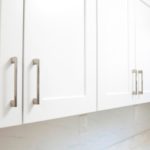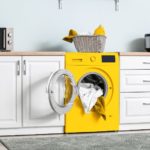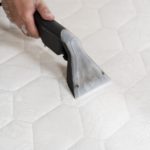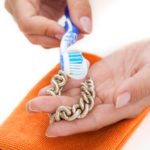There are two options when redesigning a kitchen: matt cabinets or gloss ones. Matt kitchen cupboards are a stylish and modern addition to any home kitchen. However, if your old kitchen had a high-gloss finish, your new renovation might leave you scratching your head…
How do you clean matt kitchen cupboards properly? Are they more difficult to clean than glossy cabinetry? And how can you protect the matt finish while ensuring that all grime, grease, fingerprints, and other dirt is removed?
In this guide on how to clean matt kitchen cupboards, we answer all these questions and more. And for an effective clean, you only need a few products you likely already have in your cupboards.
Here are three tried-and-tested methods you can try depending on the level of cleaning power you need.
Method 1: Soapy Water (Best for General Cleaning)

Cleaning kitchen cabinets with soap and water is a simple and effective method, perfect for general cleaning of your matt-finish kitchen. Here’s a step-by-step guide:
Materials needed:
- Mild washing-up liquid
- Warm water
- Soft microfibre or cotton cloths
- Sponge or soft brush
Step-by-step guide:
- Step 1: Remove dust – Use a dry microfibre cloth or duster to remove loose dust from the cabinet surfaces. This makes the dirt and grease easier to remove in the following steps.
- Step 2: Prepare cleaning solution – Mix a few drops of mild dish soap with warm water in a bowl. Ensure the soap is gentle and doesn’t contain harsh chemicals that could damage the finish. Swirl with your fingers to combine.
- Step 3: Spot test – Before applying the cleaning solution to the entire cabinet, perform a spot test to ensure it won’t damage the matt finish. Dip a clean microfibre cloth in the soapy water and apply it to a hidden area.
- Step 4: Wet the cloth or sponge – If the spot test showed no damage, dip a soft cloth or sponge into the soapy water. Wring out excess water to avoid soaking the cabinets.
- Step 5: Wipe surfaces – Gently wipe down the cabinet surfaces with the damp cloth or sponge. Work from top to bottom, paying extra attention to areas with built-up grime. If your matte cabinets have a grain pattern, wipe in the direction of the grain to avoid streaks.
- Step 6: Rinse with water – Dip a clean cloth in warm water and once again wring out the excess moisture. Wipe this cloth over the cabinets and doors to remove any soapy residue that could impact the appearance of the matt finish.
- Step 7: Dry immediately – After cleaning, use a dry microfibre cloth to wipe away any residual moisture from the surface immediately. This helps prevent water spots and streaks.
You may need to repeat the above cleaning process several times for stubborn spots or greasy stains.
You can also use a slightly more concentrated soap solution for tough areas, or one of our alternative cleaning options below.
Method 2: Vinegar Solution (Best for Removing Greasy Fingerprints)
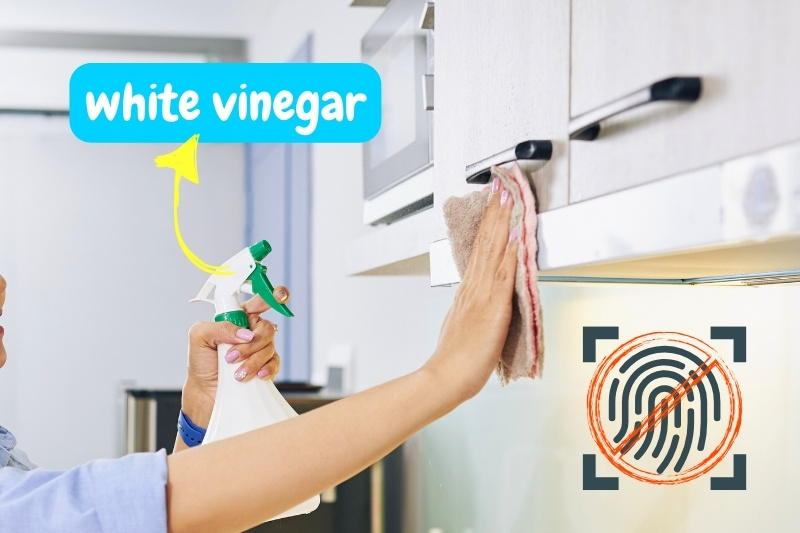
Cleaning your matt kitchen unit with soap and water is usually enough to remove dirt and grime effectively.
However, white vinegar can be integrated into the above process for a more powerful cleaning solution. White vinegar is especially effective at removing stubborn, greasy fingerprints.
To use vinegar to clean your matt kitchen cupboards, follow these steps:
- Mix equal parts white vinegar and water into a spray bottle. Screw on the lid and shake gently to combine—this is your homemade cleaning solution.
- Spray a small amount of the white vinegar solution directly onto the matt kitchen cupboards, focusing on the areas with greasy fingerprints or oily stains.
- Allow the vinegar to sit for 1 to 2 minutes to cut through the grease, then wipe the solution away using a clean microfibre cloth.
- Repeat if necessary, then dry the matt surface thoroughly with a dry cloth to prevent streaks and water spots from forming on your kitchen cupboards.
Top Tip: While vinegar is an effective cleaner, it has a strong smell. If the odour is a concern, add a few drops of essential oil (such as lemon or lavender) to the solution for a more pleasant scent.
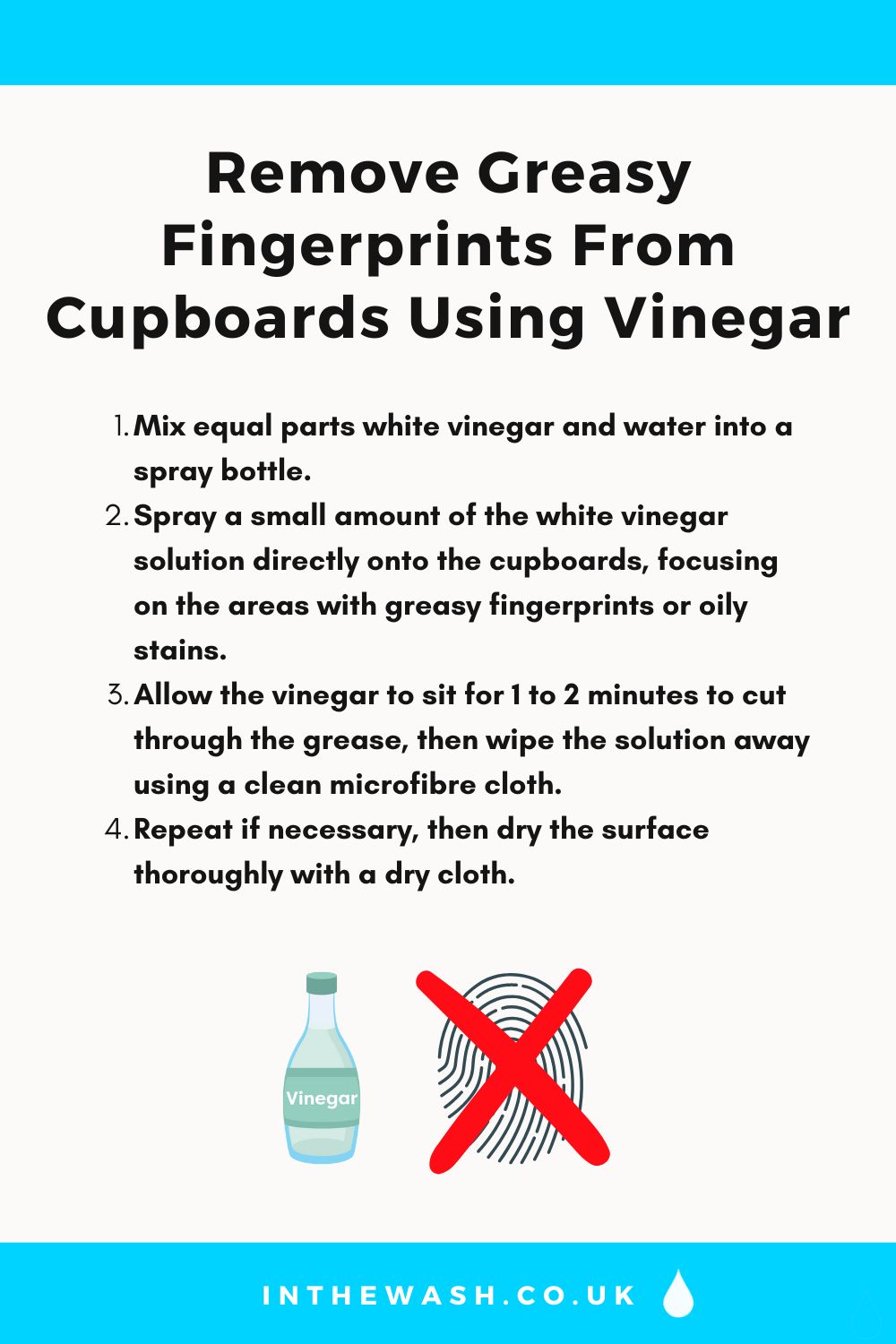
Method 3: Bicarbonate of Soda (Best for Stubborn Stains)
For stubborn stains on matt kitchen cupboards, bicarbonate of soda (also known as baking soda) is your best option. It is a gentle yet effective option, able to remove marks without causing damage to the finish.
This all-purpose cleaning product can remove food splatters, greasy stains, beverage spills, and more.
To use bicarbonate of soda for cleaning matt kitchen units, follow these steps:
- Create a cleaning paste: In a bowl, mix bicarbonate of soda with a small amount of water to create a thick paste. The consistency should be similar to toothpaste.
- Apply the paste: Using a soft cloth or sponge (avoid using abrasive brushes or scourers), apply the paste directly to the stained area on the cupboard. Make sure to cover the entire stained surface thoroughly.
- Let it sit: Allow the bicarbonate of soda paste to sit on the stain for at least 5 to 10 minutes. This gives the baking soda time to interact with and absorb the stain.
- Gently scrub: Gently scrub the stained area with a soft cloth, again avoiding rough brushes or scourers that may damage the finish. Bicarbonate of soda is a natural abrasive, so no extra scrubbing is needed. Use circular or back-and-forth motions to lift the stain.
- Rinse with water: Once you’ve scrubbed the stain, dip a clean microfibre cloth into warm water. Use this cloth to rinse the area and remove the bicarbonate of soda residue.
- Dry the surface: You may need to repeat the process for stubborn stains. After properly eliminating the stain, dry the surface thoroughly with a dry cloth. This helps prevent water spots and streaks on the matt finish.
Top Tip: If you’re dealing with stubborn grease stains, try making your cleaning paste from bicarbonate of soda, water, and vinegar—the grease-cutting properties of vinegar help to cut through the oil to lift the stain more easily.
How Do You Get Fingerprints Off Matt Kitchen Cabinets?
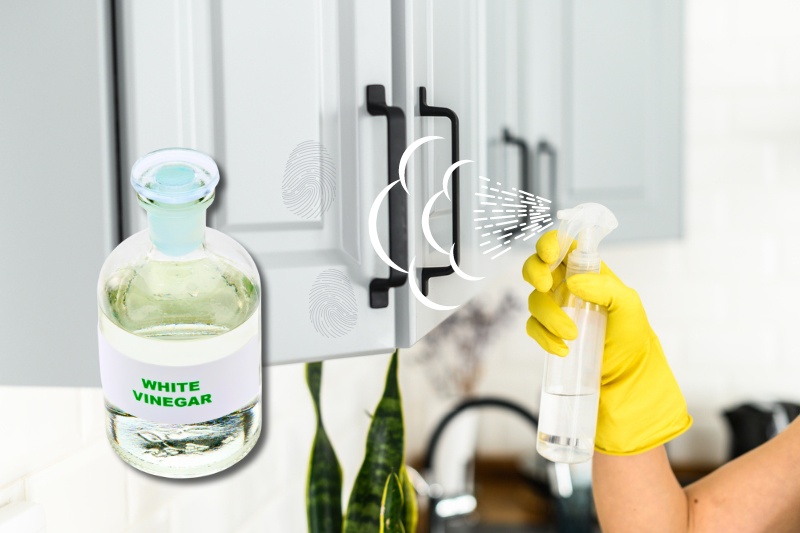
Fingerprints are one of the biggest annoyances in the kitchen. Sticky or greasy fingers can easily leave smudges and marks on your kitchen cabinets!
While matt finishes tend to hide fingerprints better than glossy cupboards, they still make their way onto your matt kitchen unit.
The best way to get fingerprints off matt kitchen surfaces is with our second cleaning method using white vinegar.
White vinegar is effective at removing greasy fingerprints and stains due to its acidic nature and solvent properties:
- Vinegar has mildly acidic properties. As grease and oil are typically acidic or neutral, the acidity in the vinegar makes it effective in cutting through these substances.
- The acetic acid in vinegar acts as a natural degreasing agent. It can effectively cut through the oily residue left by fingerprints, making it easier to wipe away.
- Vinegar is a solvent, meaning it can dissolve other substances. It can loosen the bonds between the grease and the matt cupboard surface, making it easier to remove.
On top of this, vinegar also possesses mild antibacterial properties. These can be beneficial in a kitchen environment where good hygiene is paramount.
Vinegar thus serves a double purpose, helping to sanitise surfaces in addition to removing grease from kitchen cabinets.
Are Matt Cabinets Hard to Clean?
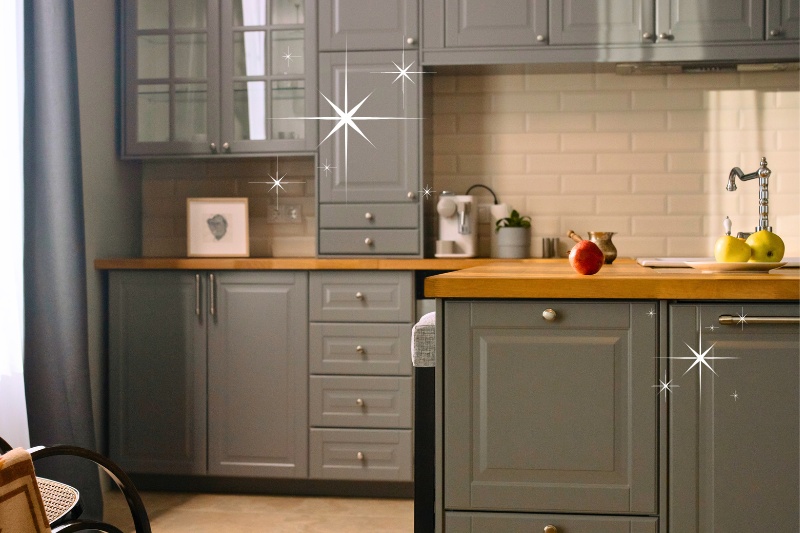
Matt kitchen cabinets can be harder to clean than glossy finishes for two main reasons:
- Matt finishes can be more susceptible to scratches compared to glossy surfaces. You must be careful when choosing cleaning products and equipment to avoid damaging the finish.
- Water spots and steaks form more easily on matt kitchen units than on high-gloss ones. It’s essential to use products sparingly and dry the cupboards quickly after cleaning.
Fortunately, these two “difficulties” related to cleaning matt kitchen cabinets are easily mitigated using the right cleaning products and techniques.
Get into good habits and use the proper cleaning products, and cleaning matt surfaces is no more challenging than any other surface in your home.
General Tips on How to Clean Matt Kitchen Cabinets
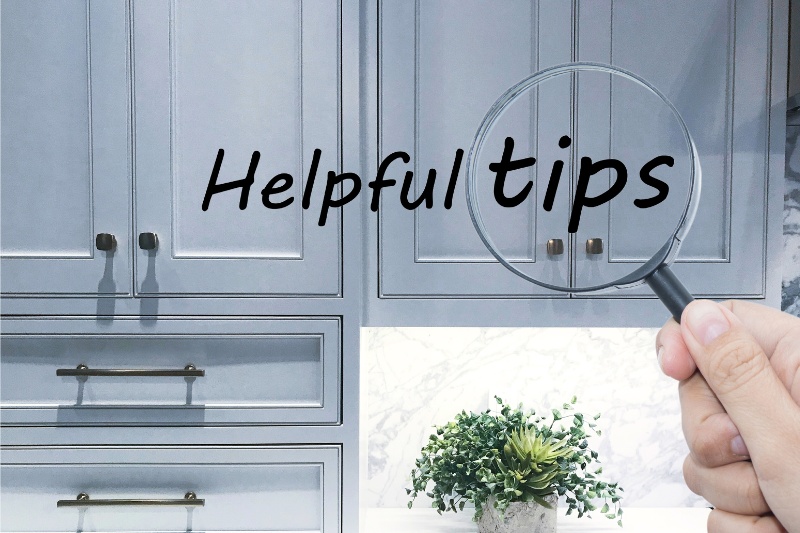
To summarise all the important information we’ve covered in this “How to Clean Matt Kitchen Cupboards” guide, here are our top tips for you to take away:
- Use soft cloths only: Avoid using abrasive sponges or scouring pads when cleaning matt kitchen cupboards (or any matt surface). They can scratch and damage the finish, whereas soft sponges or microfibre cloths help to protect it.
- Clean the cabinets regularly: Try to get into the habit of wiping your kitchen cupboards frequently as part of your weekly cleaning schedule. This reduces the need for deeper cleaning and helps the matt finish look better for longer.
- Use mild cleaning solutions: Stick to using mild cleaning solutions when cleaning matt kitchen units, such as soapy water or a commercial cleaner designed specifically for matt paint. These effectively remove grime without damaging the finish.
- Avoid excess moisture: Matt finishes are more susceptible to water spotting, so avoid using excess moisture. Use your cleaning solution sparingly and wring out the cloth or sponge well before wiping the surfaces. A little goes a long way!
- Dry immediately: After cleaning, use a dry microfibre cloth to wipe away any residual moisture immediately. Promptly drying the surfaces helps prevent water spots and streaks, giving your matt kitchen cupboards a like-new appearance.
- Use vinegar for grease: The main challenge with cleaning matt cupboards is keeping greasy fingerprints at bay. Vinegar is the best option for dealing with greasy spots—mix equal parts vinegar and water and wipe over the surfaces.
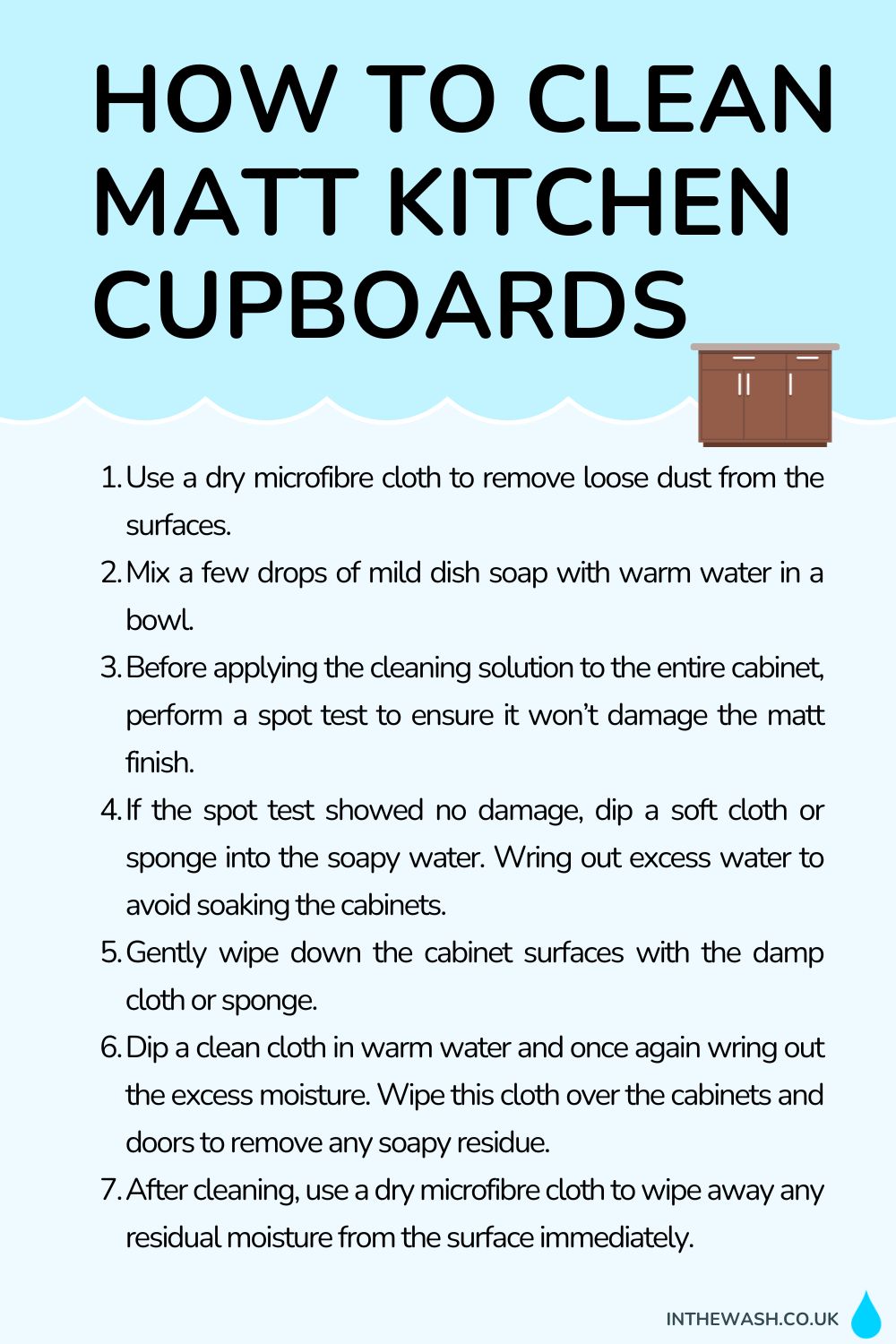

Hannah has a passion for cleaning. She worked her way around Australia by cleaning hostels in exchange for free accommodation and used her cleaning skills to bag a job as a chalet host for a luxury ski company in France.

